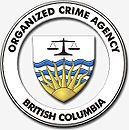- Organized Crime Agency of British Columbia
-
Organized Crime Agency of British Columbia Abbreviation OCABC OCABC Logo Agency overview Formed March 11, 1999 Dissolved April 1, 2004 Superseding agency Combined Forces Special Enforcement Unit - British Columbia Legal personality Governmental: Government agency Jurisdictional structure Operations jurisdiction* Province of British Columbia, Canada Constituting instrument BC Police Act General nature Operational structure Website http://www.ocabc.org/ Footnotes * Divisional agency: Division of the country, over which the agency has usual operational jurisdiction. The Organized Crime Agency of British Columbia (March 11, 1999– April 1, 2004) was a Crown corporation created as a 'Designated Policing and Law Enforcement Unit' regulated by the British Columbia Police Act and the British Columbia Emergency Program Act. In October 1998, following the recommendations of the Independent Review Committee on Organized Crime, chaired by Stephen Owen, Attorney General Ujjal Dosanjh announced plans for Organized Crime Agency to replace the 'Coordinated Law Enforcement Unit' (CLEU) which was found by the Owen Report to be not sufficiently equipped, mandated, or able to cope with the growing sophistication and diversity of organized crime.
Its mandate is "to facilitate the disruption and suppression of organized crime which affects all British Columbians." Effective April 1, 2004 the agency was integrated with their Royal Canadian Mounted Police (RCMP) counterparts to create the federal-led Combined Forces Special Enforcement Unit - British Columbia which also created the Integrated Gang Task Force (IGTF).
Contents
Structure
The agency was staffed civilian professionals that specialized in intelligence analysis, law, forensic accounting, computer science and foreign languages. In addition to its sworn police officers, investigators from municipal police departments and the BC-based RCMP detachments were assigned to the agency on 3 to 5 year terms. It was governed by a board which consists of the Deputy Commissioner of RCMP "E" Division, the President of the BC Association of Municipal Chiefs of Police, the President of the BC Association of Chiefs of Police, the Chief Constable of the Vancouver Police Department, and four government appointed members.
Operations
In 2002-2003, the agency participated in Project Blizzard with Alberta and U.S. authorities in investigating drug trafficking. This project had 689,000 pseudoephedrine tablets, 64.7 kilograms of cocaine, 3,353 pounds of marijuana, and $4 million seized. The 5-month Project Longhaul in 2003 investigated distribution and transportation of marijuana, ecstasy, and ephedrine from British Columbia to Ontario and the U.S. and resulted in 3,872 pounds of marijuana, 20,000 tablets of ecstasy, and 218.2 kilograms of ephedrine being seized. Project Longhaul II specifically focused on BC Bud and had 1,595 pounds of marijuana, and 461 marijuana plant clones seized.[1]
Notes
- ^ OCA 2003/2004, 8-9.
See also
- Combined Forces Special Enforcement Unit - British Columbia
External links
References
- (pdf) Annual Report. 2002/2003. Province of British Columbia. 2003. http://www.gov.bc.ca/cas/down/ocabc_2003_annual_report.pdf. Retrieved 2007-08-11.
- (pdf) Annual Report. 2003/2004. Province of British Columbia. 2004. http://www.gov.bc.ca/cas/down/2003_04_annual_reports/2003_04_organized_crime_annual_report.pdf. Retrieved 2007-08-11.
- Stephen Schneider et al. (March 31, 2000) (pdf). Alternative Approaches to Combating Transnational Crime. Final Report. Ministry of the Solicitor General of Canada. http://ww2.ps-sp.gc.ca/Publications/Policing/TransCrime_e.pdf. Retrieved 2007-08-11.
Categories:- Defunct law enforcement agencies of Canada
- Law enforcement agencies of British Columbia
Wikimedia Foundation. 2010.

